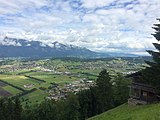Planken
Planken | |
|---|---|
 Overlooking Planken | |
 Planken and its exclaves in Liechtenstein | |
| Coordinates:47°11′N9°32′E/ 47.183°N 9.533°E | |
| Country | |
| Electoral district | Oberland |
| Villages | none |
| Area | |
| • Total | 5.34 km2(2.06 sq mi) |
| Elevation | 786 m (2,579 ft) |
| Population (31-12-2019)[1] | |
| • Total | 473 |
| • Density | 89/km2(230/sq mi) |
| Time zone | UTC+1(CET) |
| • Summer (DST) | CEST |
| Postal code | 9498 |
| Area code | 7006 |
| ISO 3166 code | LI-05 |
| Website | www.planken.li |
Planken(German pronunciation:[ˈplaŋkn̩]) is amunicipalityinOberland,Liechtenstein.It has four exclaves, two enclaves and a population of 473.[1]Thus by population it is the smallest municipality of Liechtenstein.
Geography[edit]
It is located on the western slope ofDrei Schwestern.The center of the main village is on 786m a.s.l.. Additionally the plateau of Oberplanken belongs to the municipality. It borders onGamprin's exclave Nendler Berg, theVaduz'exclave Dachsegg andEschenin the North, on theAustrianmunicipality ofFrastanzin the East and onSchaanin the South and in the West.[2]
The exclavePlankner Garselliis a former alp in theSamina valley.[2]ThePlankner Neugrüttis a cliffy forest north of the village, separated from it by a stripe of 20m of land and surrounded by an exclave of Schaan with the same name.[3]The other two exclaves are in theRhine Valley:Wesis a small meadow andRiet-Äscheris a marsh, both are surrounded by territory of Schaan.[2]
Furthermore, there are two enclaves consisting of woods: Rüttistein, which belongs to Vaduz, and Schaan's Brunnenegg.
Alps[edit]
There are fouralpsin the municipality:
| Alp | Etymology | Owner | Total area | Pasture area | Source |
|---|---|---|---|---|---|
| Gafadura | OldRomansh:cavradüra(clearing) | Municipality
of Planken |
90ha | 24ha | [4] |
| Alpzinka | tapering part of the alp | [5] | |||
| Rütti | Mentioned 1607 asReiti(clearing) | 22ha | [6] | ||
| Plankner Garselli | Old Romansh:clusella(small gully)? | 187ha | - | [7] | |
The alp Gafadura on the western slope ofDrei Schwesternwas settled byWalser,alikeSaroja,fromTriesenbergand inhabited until the 15th century. In 1579 the owners of Gafadura, Gaflonen (today: Alpzinka) and Garselli handed their formercooperativealps over to the municipality. It was first given to single farmers until 1875 when it became a communal farming project until 1960. Since then its use is limited to cattle farming and the forestry industry. The Gafadura chalet was built 1926 as a princely hunting lodge and taken over by the Liechtensteiner Alpenverein in 1968.[4]
Alpzinka was first mentioned in 1428 and was probably settled until the mid-15th century. Since then this area belonging to Gafadura was used for agriculture.[5]
Rütti, formerly also known as "Maiasäss" was used as a Maiensäss for Gafadura.[6]
Plankner Garselli is located in the westernSamina Valley.The use of this steep and dry alp was not intensive since the 19th century and was limited to cattle. The agricultural activity ceased between 1880 and 1890. Since 2000 it is part of the Natural Forest ReserveGarselli/Zigerberg.[7]
History[edit]
The Romanic population from Schaan and Vaduz had already cleared the area of the village before theWalsermigrated there in the 13th century and started clearing the upper parts of the municipality. The first documented naming was in the year 1361. The village was looted twice, first by the Swiss in 1499 when they campaigned againstFrastanzand in 1799 by the French when they ousted the Austrian forces during theNapoleonic Wars.
In 1868 the village was connected to the rest of Liechtenstein via road, making it reachable for bigger carriages. After a great conflagration in 1869 an exodus hit the village; in 1901 just 56 inhabitants remained. The situation improved due to a land reform from 1961 to 1981 and an enlargement of infrastructure.[2]
Politics[edit]
Thecommunity leadersince 2007 is Rainer Beck (VU). In the 2015 regional elections, he received 67.3% of the valid votes.
In the communal council, four seats are held byFBPand three byVU.[8]
Sights[edit]
Its most notable structure is an eighteenth-century chapelSt. Josef,which belongs to the parish of Schaan. It is supposed to have been built in 1761 and in 1861 a tower was added that contains a bell from 1724. 1929 PrinceFranz I.founded the chapel's threebaroque revivalaltars. It was then redesigned in 1955 under the supervision of architect Felix Schmid ofRapperswil.[9]
Notable people[edit]
- Hanni Wenzel,alpine skier
- Andreas Wenzel,alpine skier
- Petra Wenzel,alpine skier
- Tina Weirather,alpine skier
- Jessica Walter,alpine skier
Gallery[edit]
-
View of the valley from the Planken hillside
-
Village church
-
View with fog
References[edit]
- ^abhttps://www.llv.li/files/as/bevolkerungsstatistik-30-juni-2017.pdf[bare URL PDF]
- ^abcd"Planken – Historisches Lexikon".historisches-lexikon.li(in German).Retrieved2019-05-18.
- ^"Swiss Geoportal".map.geo.admin.ch.Retrieved2019-05-18.
- ^ab"Gafadura – Historisches Lexikon".historisches-lexikon.li(in German).Retrieved2019-05-18.
- ^ab"Alpzinka – Historisches Lexikon".historisches-lexikon.li(in German).Retrieved2019-05-18.
- ^ab"Rütti – Historisches Lexikon".historisches-lexikon.li(in German).Retrieved2019-05-18.
- ^ab"Garselli – Historisches Lexikon".historisches-lexikon.li(in German).Retrieved2019-05-18.
- ^"Gemeindewahlen Liechtenstein".www.gemeindewahlen.li.Retrieved2019-05-18.
- ^Herrmann, Cornelia (2007).Die Kunstdenkmäler des Fürstentums Liechtenstein.pp. 409–411.
External links[edit]
![]() Media related toPlankenat Wikimedia Commons
Media related toPlankenat Wikimedia Commons





